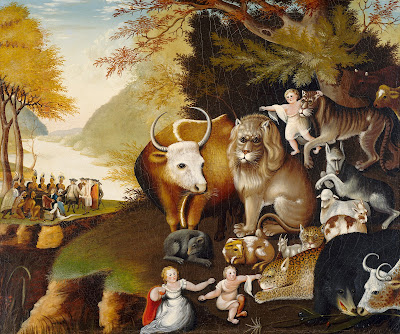Today's observance is classified as a "lesser festival" on the calendar of the Evangelical Lutheran Church in America. "Name of Jesus" was originally called the "Octave" because it fell on the eighth day of Christmas. It was first observed by sixth century Roman Catholics. We celebrate the name of Jesus, given to him by an angel before he was even conceived, and look to the day when every tongue confesses "that Jesus Christ is Lord, to the glory of God the Father."
We're a couple days past the mid-point of Christmas - but it is STILL Christmas. Today's worship service includes a service of Christmas Lessons and Carols - scripture readings and hymns.
Most of these readings are chosen from the traditional observance of Lessons and Carols at King's College in Oxford, England - a service first sung in 1918. The last two readings are from the propers for the day.
Most of these readings are chosen from the traditional observance of Lessons and Carols at King's College in Oxford, England - a service first sung in 1918. The last two readings are from the propers for the day.
OPENING VOLUNTARY Chorale Prelude on "O Come, All Ye Faithful" (Adeste fideles)
Sigvart A. Hofland / attr. John Francis Wade
GATHERING HYMN Once in Royal David's City (Irby) ELW 269
This hymn, a jubilant cry of welcome, bids the Savior to come fulfill the promise of the Genesis reading.
SECOND CAROL In a Deep, Unbounded Darkness (Divinum mysterium) ACS 1093
This text that originated as the theme song for a Bible Study institute in China is a meditation on the eternal nature of God. Like the hymn "Of the Father's Love Begotten," with which this tune is often paired, we begin in the time before creation when God claimed us. After praising God's steadfastness in stanza two, our joy overflows at the incarnation in stanza three. Finally, stanza four returns us to the realm of eternity, joining together the beginning and final chapters of the Bible by connecting references to stories from Genesis and Exodus with the wedding feast of the Lamb in Revelation. (From Sundays and Seasons)
THIRD CAROL He Came Down (He Came Down) ELW 253
The reading tells us that a child has been born. This traditional song from Cameroon tells us why he has been born.
FOURTH CAROL O Little Town of Bethlehem (St. Louis) ELW 279
At this point in our service we'll only sing stanzas 1 - 3. We'll sing stanza four as the offering hymn. "Oh, Holy Child of Bethlehem, descend to us, we pray" is usually sung with a mind to the incarnation. Moving it to the spot just before communion gives it a different spin, reminding us of Christ's true presence in the eucharist.
FIFTH CAROL From Heaven Above to Earth I Come (Vom Himmel hoch) ELW 268
This is a true Lutheran hymn with a text and tune both attributed to Martin Luther. The first three stanzas are sung from the point of a Christmas angel announcing the birth of God's son. The next set of verses are from our point of view and end with us joining in the song of angels.
SIXTH CAROL At the Name of Jesus (Noel nouvelet)
This hymn is usually sung on Christ the King Sunday to a stolid English tune. Just for fun, and to highlight the Christmas season a little more, the text is paired today with the tune of a traditional French Christmas carol. (Modern worshipers may associated the hymn with Easter since it is often sung as "Now the Green Blade Rises.")
HYMN OF THE DAY Love Has Come
MUSICAL OFFERING All My Heart Again Rejoices
 |
| Jerusalem Lutheran Church near Rincon, Georgia |
In 1731 a group of German protestants, known as the Salzburger emigrants, were expelled from their homeland by Count Leopold Anton Firmian, the Prince-Archbishop of Salzburg. Their crime? They refused to recant their faith.
The group's leader, Pastor Samuel Urlspurger, asked King George II for help and he granted them land in Ebenezer, Georgia - about 55 miles from Atlanta. About 150 of the Salzburgers established the town in 1734. It was not successful since the lands was too far from water to be fertile and many of the settlers died.
They resettled near the Savannah River where they built Jerusalem Lutheran Church in 1769. (It is Georgia's oldest church building still in use.) This time their community prospered, but only after they introduced slavery - something the community had initially been against.
There is a story that they were singing this hymn as they left Austria.
COMMUNION HYMN In the Bleak Midwinter (Cranham) ELW 294
COMMUNION HYMN It Came Upon the Midnight Clear (Carol) ELW 282
SENDING HYMN Good Christian Friends, Rejoice (In dulci jubilo) ELW 288
CLOSING VOLUNTARY Trumpet Tune on "Noel nouvelet"
Wayne L. Wold
sources:
Wikipedia, including the photo of Jerusalem Lutheran Church By Bubba73 (Jud McCranie) - Own work, CC BY-SA 4.0, https://commons.wikimedia.org/w/index.php?curid=44838325
Hymnal Companion to Evangelical Lutheran Worship, Paul Westermeyer
Manual on the Liturgy, Lutheran Book of Worship
https://www.kings.cam.ac.uk/
Manual on the Liturgy, Lutheran Book of Worship
https://www.kings.cam.ac.uk/

.jpg)


















